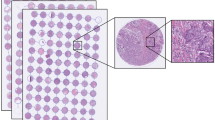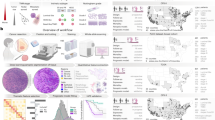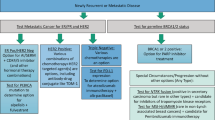Abstract
The ability of pathology characteristics to predict outcome was tested with the 1029 cancers accumulated in the Edinburgh Randomized Trial of breast screening after 14 years follow-up. The majority (55.7%) were in the screening arm, which also had more operable cases (81.3% vs 62.2%); the reduction in the proportion of inoperable breast cancers in a UK female population invited to mammographic screening is a notable effect of the trial. In the 691 operable invasive cases the size, histological type, grade, node status and node number group individually showed highly significant (P< 0.001) association with survival. In multivariate analysis the Nottingham Prognostic Index (NPI) derived from these features showed highly significant association with survival (P< 0.001). However, when first adjusted for NPI, combined addition of pathological size in 6 categories and histological type as special or not had an independent association with survival that was statistically firmly based (P< 0.001). For operable breast cancer the gains are in smaller sizes, better histological features, and higher proportion node negative. The weighting factors applied to pathology indicators of survival in the NPI are not optimal for a population included in a trial of screening. In particular, a linear trend of the index with pathological size is not appropriate. Inclusion of histological type as special or not improves the index further. © 2000 Cancer Research Campaign
Similar content being viewed by others
Article PDF
Change history
16 November 2011
This paper was modified 12 months after initial publication to switch to Creative Commons licence terms, as noted at publication
References
Alexander FE, Anderson TJ, Brown HK, Forrest APM, Kirkpatrick AE, Muir BB, Prescott RJ and Smith A (1999) 14 years of follow-up from the Edinburgh randomised trial of breast-cancer screening. Lancet 353: 1903–1908
Altman DG, Lausen B, Sauerbrei W and Schumacher M (1994) Dangers of using ‘optimal’ cutpoints in the evaluation of prognostic factors. J Natl Canc Inst 86: 829–835
Anderson TJ, Lamb J, Alexander FE, Lutz W, Chetty U, Forrest AP, Kirkpatrick A, Muir B, Roberts MM and Huggins A (1986) Comparative pathology of prevalence and incidence cancers detected by breast screening. Lancet I: 519–523
Anderson TJ, Lamb J, Doonan P, Alexander FE, Huggins A, Muir BB, Kirkpatrick AE, Chetty U, Hepburn W, Smith A, Prescott RJ and Forrest APM (1991) Comparative pathology of breast cancer in a randomised trial of screening. Brit J Cancer 64: 108–113
Anderson TJ, Alexander FE and Forrest APM (2000) The natural history of breast cancer. What have we learned from screening?. Cancer 87: 1758–1759
Andersson I, Aspergren K, Janzon L, Lundberg T, Lindholm K, Linell F, Ljungberg O, Ranstam J and Sigfusson B (1988) Mammographic screening and mortality from breast cancer: the Malmo mammographic screening trial. Br Med J, (1988). 297: 943–948
Balslev I, Axelsson CK, Zedeler K, Rasmussen BB, Carstensen B and Mouridsen HT (1994) The Nottingham Prognostic Index applied to 9149 patients from the studies of the Danish Breast Cancer Co-operative Group. Breast Cancer Res Treat 32: 281–290
Beuttner P, Garbe C and Guggenmoos-Holzmann I (1997) Problems in defining cutoff points of continuous prognostic factors: example of tumor thickness in primary cutaneous melanoma. J Clin Epidemiol 50: 1201–1210
Brown JM, Benson EA and Jones M (1993) Confirmation of a long-term prognostic index in breast cancer. Breast 2: 144–147
Cox DR (1972) Regression models and life tables (with discussion). J R Stat Soc 34: 187–220
Day NE and Duffy SW (1996) Trial design based on surrogate end points: application to comparison of different breast screening frequencies. J R Statist Soc A 189: 49–60
Day NE, Williams DRR and Khaw KT (1989) Breast cancer screening programmes: the development of a monitoring and evaluation system. Brit J Cancer 59: 954–958
Dixon JM, Page DL, Anderson TJ, Lee D, Elton RA, Stewart HJ and Forrest APM (1985) Long-term survivors after breast cancer. Br J Surg 72: 445–448
Duffy SW, Tabar L, Fagerberg G, Gad A, Grontoft O, South MC and Day NE (1991) Beast screening, prognostic factors and survival results from the Swedish two-county study. Br J Cancer 64: 1133–1138
Elston CW and Ellis IO (1991) Pathological prognostic factors in breast cancer. I. The value of histological grade in breast cancer: experience from a large study with long term follow up. Histopathol 19: 403–410
Forrest APM, Everington D, McDonald CC, Steele RJC, Chetty U and Stewart HJ (1995) The Edinburgh randomised trial of axillary node sampling or clearance after mastectomy. Brit J Surg, (1995). 82: 1504–1508
Frisell J, Eklund G, Hellstrom L and Somell A (1987) Analysis of interval breast carcinomas in a randomized screening trial in Stockholm. Breast Cancer Res Treat 9: 219–225
Galea MH, Blamey RW, Elston CE and Ellis IO (1992) The Nottingham Prognostic Index in primary breast cancer. Breast Cancer Res Treat 22: 207–219
Gasparini G (1998) Prognostic variables in node-negative and node-positive breast cancer – Part I and II. Breast Cancer Res Treat 51 (3) and 52 (1–3),
Haybittle JL, Blamey RW, Elston CW, Johnson J, Doyle P, Campbell FG, Nicholson RI and Griffiths K (1982) A prognostic index in primary breast cancer. Br J Cancer 45: 361–366
International Union Against Cancer (U. I. C. C) (1997). TNM Classification of malignant tumours, LH Sobin, Ch Wittekind (eds). 5th edition, Wiley-Liss: New York
National Coordinating Group for Breast Screening Pathology (1995) Pathology reporting in breast cancer screening. NHSBSP publication no 3 (revised),
Nystrom L, Rutqvist LE, Wall S, Lindgren A, Lindqvist M, Ryder S, Andersson I, Bjurstam N, Fagerberg G, Frisell J, Tabar L and Larsson L-G (1993) Breast cancer screening with mammography: overview of Swedish randomised studies. Lancet 341: 973–978
Page DL and Anderson TJ (1987). Diagnostic histopathology of the breast, 193–235, Churchill Livingstone: Edinburgh
Pereira H, Pinder SE, Sibbering DM, Galea MH, Elston CW, Blamey RW, Robertson JFR and Ellis IO (1995) Pathological prognostic factors in breast cancer. IV. Should you be a typer or grader? A comparative study of two histological prognostic features in operable breast carcinoma. Histopathol 27: 219–226
Roberts MM, Alexander FE, Anderson TJ, Forrest APM, Hepburn W, Huggins A, Kirkpatrick AE, Lamb J, Lutz W and Muir BB (1984) The Edinburgh randomised trial of screening for breast cancer: description of method. Br J Cancer 50: 1–6
Sauerbrei W, Hubner K, Schmoor C and Schumacher M (1997) Validation of existing and development of new prognostic classification schemes in node negative breast cancer. Breast Cancer Res Treat 42: 149–163
Scottish Cancer Therapy Network Scottish Breast Cancer audit 1987 & 1993 (1996) Report to Chief Scientist and CRAG. Information and Statistics Division, The National Health Service in Scotland
Steele RJC, Forrest APM, Gibson T, Stewart HJ and Chetty U (1985) The efficacy of lowe axillary node sampling in obtaining axillary node status in breast cancer: a controlled randomised trial. Brit J Surg 72: 368–369
Sundquist M, Thorstenson S, Brudin L and Nordenskjold B the South East Swedish Breast Cancer Study Group (1999) Applying the Nottingham Prognostic Index to a Swedish breast cancer population. Breast Cancer Res Treat 53: 1–8
Tabar L, Fagerberg CJ, Gad A, Baldetorp L, Holmberg LH, Grontoft O, Lunjguist U, Lundstrom B, Manson JC, Eklund G, Day NE and Pettersson F (1985) Reduction in mortality from breast cancer after mass screening with mammography. Lancet I: 829–832
Tabar L, Fagerberg G, Duffy SW, Day NE, Gad A and Grontoft O (1992) Update of the Swedish two county program of mammographic screening for breast cancer. Radiol Clin North Amer 30: 187–210
Tabar L, Fagerberg G, Chen H-H, Duffy SW and Gad A (1996) Tumour development, histology and grade of breast cancers: prognosis and progression. Int J Cancer 66: 413–419
Tabar L, Duffy SW, Vitak B, Chen H-H and Prevost TC (1999) The natural history of breast carcinoma. What have we learned from screening?. Cancer 86: 449–462
Tabar L, Chen H-H, Duffy SW, Yen MF, Chiang CF, Dean PB and Smith RA (2000) A novel method for prediction of long-term outcome of women with T1a, T1b, and 10–14 mm invasive breast cancers: a prospective study. Lancet 355: 429–433
Todd JH, Dowie C, Williams MR, Elston CW, Ellis IO, Hinton CP, Blamey RW and Haybittle JL (1987) Confirmation of a prognostic index in primary breast cancer. Br J Cancer 56: 489–492
Author information
Authors and Affiliations
Corresponding author
Rights and permissions
From twelve months after its original publication, this work is licensed under the Creative Commons Attribution-NonCommercial-Share Alike 3.0 Unported License. To view a copy of this license, visit http://creativecommons.org/licenses/by-nc-sa/3.0/
About this article
Cite this article
Anderson, T., Alexander, F., Lamb, J. et al. Pathology characteristics that optimize outcome prediction of a breast screening trial. Br J Cancer 83, 487–492 (2000). https://doi.org/10.1054/bjoc.2000.1286
Received:
Revised:
Accepted:
Published:
Issue date:
DOI: https://doi.org/10.1054/bjoc.2000.1286
Keywords
This article is cited by
-
Survival estimates stratified by the Nottingham Prognostic Index for early breast cancer: a systematic review and meta-analysis of observational studies
Systematic Reviews (2018)
-
The pattern of prognostic and risk indicators among women with breast cancer undergoing modified radical mastectomy in Dar es Salaam, Tanzania
Infectious Agents and Cancer (2016)
-
Prognostic and therapeutic significance of ribonucleotide reductase small subunit M2 in estrogen-negative breast cancers
BMC Cancer (2014)
-
Molecular profiles of screen detected vs. symptomatic breast cancer and their impact on survival: results from a clinical series
BMC Cancer (2013)
-
A mitotically active, cellular tumor stroma and/or inflammatory cells associated with tumor cells may contribute to intermediate or high Oncotype DX Recurrence Scores in low-grade invasive breast carcinomas
Modern Pathology (2012)



